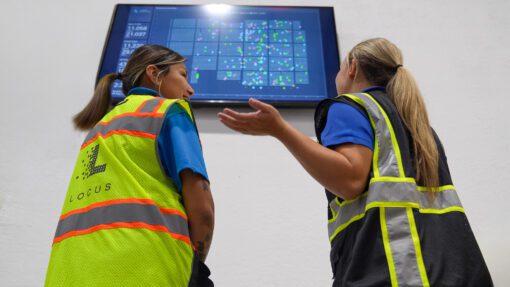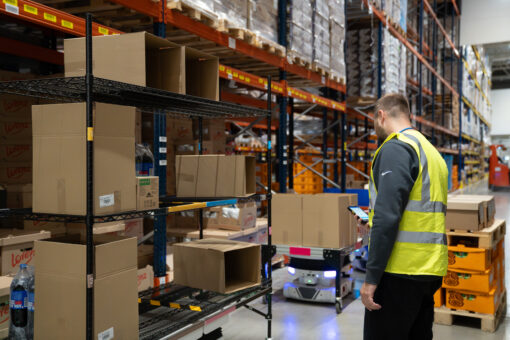WP: How to achieve 400 UPH with Locus Fast Pick
WP: How to achieve 400 UPH with Locus Fast Pick Download Now!
Demystifying Warehouse Robots: Automation Simplicity Over Complexity
Mary Hart, Sr. Content Marketing Manager

When it comes to warehouse automation, there are many persistent myths that need debunking: the one behind this blog post is the myth that warehouse robots are overly complex, too complicated, and over-engineered, which makes them impractical for most companies. The truth is that while warehouse robotics are an advanced technology, they are far from being inaccessible or overly complicated. In fact, modern autonomous mobile robots (AMRs) are designed with simplicity, ease of use, and flexibility at their core, catering to a broad range of warehouse needs — from small-scale operations to large, multi-site enterprises.
Myth Busting: Are Warehouse Robots Really Too Complicated?
There’s a common perception that integrating robots into your warehouse operations is hard and requires a PhD in robotics, complex programming, and constant IT support. However, this couldn’t be further from the truth.
Today’s AMRs are designed to be user-friendly and intuitive. They are built with plug-and-play capabilities, which means they can be integrated into your warehouse with minimal disruption and you don’t need to shut down your whole warehouse or even part of it in order to bring on robots.
User interfaces on AMRs are straightforward and often designed with the end-user — the warehouse associate — in mind. Just as you don’t need to understand the inner workings of a smartphone to use one effectively, you don’t need to be a robotics expert to leverage the power of AMRs in your warehouse.
From Complex to Simple: The Evolution of Warehouse Robotics
The notion of over-engineered robots likely stems from the earlier generations of warehouse automation. These older systems were indeed (and some still are…) large, fixed installations that required major infrastructure modifications and long lead times to implement. They were often rigid, costly, and could only perform a limited range of functions. If something changed in the warehouse process, these systems required additional investment to reconfigure.
AMRs, however, represent a significant departure from this legacy. They are highly adaptable, able to operate in diverse environments, and require no fixed infrastructure. Modern AMRs are equipped with advanced sensors, AI-driven navigation, and collaborative capabilities that allow them to move seamlessly around human workers and dynamic obstacles instead of having to be fenced off or kept away from. What’s more, their deployment does not necessitate a full warehouse shutdown or lengthy training periods. This simplicity is by design, enabling quick setup and immediate value realization.
Easy Integration with Existing Systems
Another point of concern for warehouse managers is how well robots will integrate with their existing warehouse management systems (WMS) or other software. Many fear that robotic solutions require completely new systems or substantial overhauls of current operations. This is another misconception.
Most AMR solutions today are designed to integrate smoothly with your existing WMS and ERP systems. They are built with interoperability in mind, using standard APIs and protocols that allow them to 'talk' to your systems effortlessly. This means that rather than uprooting your current processes, AMRs enhance and augment them, providing more efficiency and visibility without a steep learning curve or added complexity.
Real-World Examples of Simplicity in Action
To put things in perspective, consider a typical scenario in an e-commerce warehouse. Before deploying AMRs, warehouse associates might spend hours each day walking long distances of 12 to 15 miles each day to pick items, which leads to fatigue, errors, and slower fulfillment times. With the introduction of AMRs, however, the robots handle the transport, allowing associates to focus on high-value tasks, such as the actual picking, packing, putaway, or quality control.
Despite what some might expect, the deployment is straightforward: the robots arrive at the warehouse, are connected to the WMS, and within a few days, they’re up and running. Associates need only minimal training to operate alongside the robots (which is especially helpful for bringing on temporary peak season associates), and within weeks, the operation sees measurable improvements in productivity and accuracy. This is the reality of modern AMR deployment — far from complex, it’s quick, efficient, and remarkably intuitive.
Robots Designed for Humans
Another common myth is that robots are designed to replace humans. We’ve talked about this often. However, the best AMRs are designed for human-robot collaboration, not replacement. They help humans by taking over repetitive, physically strenuous, and mundane tasks, which can reduce workplace injuries and enhance job satisfaction.
For example, our LocusBots are engineered to work seamlessly with human associates. They autonomously navigate the warehouse, reduce walking time by bringing the work to the associate, and adapt to changing conditions without requiring extensive programming or system overhauls. This simplicity of operation allows for easy, fluid collaboration between human and robot.
Robots Offer Simple Productivity
The myth that warehouse robots are too complex, complicated, and over-engineered fails to recognize the technological advancements that have made these systems accessible, user-friendly, and highly effective. Instead of being cumbersome or complicated, today’s AMRs are designed to be easily integrated, quickly scalable, and ready to deliver value from day one.
As warehouses continue to evolve and adapt to new market demands, flexibility and simplicity are more critical than ever. AMRs in the form of LocusBots represent a future where automation is not a complicated, daunting challenge but an easy and efficient step toward greater productivity, better employee satisfaction, and improved bottom lines.
So, if you're considering robots for your warehouse but are held back by the myth of complexity, it's time to rethink. Let Locus Robotics help you dispel these myths and see how simple and impactful robotic automation can truly be.
If you're ready to explore how Locus Robotics can simplify your warehouse operations instead of complicating it, let’s talk.




